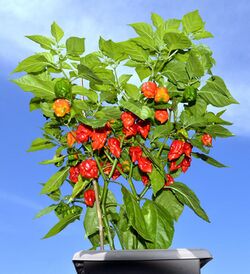Biology:Race to grow the hottest pepper
The race to grow the hottest pepper is an informal competition since the early 1990s among growers of chili peppers primarily in the US, the UK, and Australia, to develop ever-hotter peppers. Pepper species and cultivars registering over 1,000,000 Scoville Heat units (SHU) are called "super-hots".
History
Before the early 1990s there were only two peppers which had been measured above 350,000 SHU, the Scotch bonnet and the habanero.[1] California farmer Frank Garcia used a sport of a habanero to develop a new cultivar, the Red Savina, which was measured at 570,000 in 1994.[1][2] At the time this was considered to represent an upper limit of chili pepper hotness.[1]
In 2001 Paul Bosland, a researcher at the Chile Pepper Institute at New Mexico State University, visited India to collect specimens of Bhut jolokia, also called the ghost pepper or Naga king chili,[3] traditionally grown near Assam, India, which was being studied by the Indian army for weaponization.[1][4] When Bosland grew and tested the pepper, he discovered it measured over 1 million SHU.[1] According to Bosland, this "kind of opened the floodgates".[1]
In 1994 the Red Savina was named the hottest pepper by Guinness World Records.[1] In 2006 the Dorset Naga was claimed to be the hottest.[2] In 2007 Guinness certified the Bhut jolokia as the world's hottest.[2] In 2011 first the Infinity, then the Naga Viper, then the Trinidad Scorpion Butch T pepper were recognized by Guinness as the hottest.[2][5] In 2012, the Chili Pepper Institute called the Trinidad Moruga scorpion the new hottest pepper, saying it had been measured at 2 million SHU, the first time the 2-million mark had been reached.[2] In 2013 Guinness recognized the Carolina Reaper.[2]
Many of the cultivars developed in the attempt to produce ever-hotter peppers are hybrids of chilis traditionally grown in India and Trinidad and, as of 2013, "were virtually unknown in the US until recently".[6]
Super-hots
The new peppers have been termed "super-hots".[6] Super-hots are classified as peppers registering over 1 million SHU.[7][8][9]
In 2015 Bosland and his team, using fluorescence microscopy, found that while most peppers store capsaicin primarily in their pith, super-hot varieties tend to store as much in their flesh as they do in their pith.[8] While for most peppers removing the pith and seeds also removes much of the heat, for super-hots this is not true.[8] Super-hots not only have more capsaicin than other peppers but also store their capsaicin differently.[8] In their report, Bosland et al call it a "novel discovery that these 'super-hot' chile peppers have developed accessorial vesicles on the pericarp tissue in addition to the vesicles on the placental tissue, thus leading to exceedingly high Scoville heat units for these plants."[7]
Super-hots also have "rumpled walls", likely a genetic mutation, resulting in more area in which to store capsaicin and therefore more heat.[9]
The theoretical upper limit of super-hots is 16 million SHU, the level of pure capsaicin, but super-hots are likely to top out lower than this, as in any possible fruit the capsaicin would be diluted by other plant tissues.[9] In 2016 Bosland hypothesized a 3 or 4 million SHU pepper.[9] Super-hots should be handled with gloves and using eye protection, as contact with even a single seed can cause skin irritation via chili burn.[2]
Competition and certification
Chili growers compete with one another "ruthlessly" to create the world's hottest pepper.[1] According to Marc Fennell, creator of the podcast It Burns, the competition "is a hugely controversial war – there are scandals, accusations of cheating, death threats."[10] According to Maxim, the race has "ignited heated debate" among chiliheads (or chileheads) and raised "deep questions about science, ethics, and honor."[6][11] While competition takes place mainly among UK, Australian, and US growers, the competition in the US is noted for "negativity and fighting."[12]
The "crowning achievement" is being listed in Guinness World Records.[6] Guinness has been criticized by Trinidad Moruga scorpion creator Jim Duffy for "bestowing the title on insufficiently authenticated fruits",[13] and the company has not named a new hottest pepper since recognizing the Carolina Reaper in 2013, despite the entry of at least two contenders. Duffy argued in 2011, when Guinness named the Naga Viper the world's hottest pepper, that the hybrid of three peppers (Naga Morich, Trinidad Scorpion and bhut jolokia) could not have been developed within the time frame, as a three-way hybrid would require 10 years or longer to create.[13] Industry expert Dave DeWitt in 2011 called for "an independent certifying authority that takes the place of Guinness and requires at least two separate tests for each submission".[13]
According to The Atlantic, there is speculation among chiliheads that Guinness is reluctant to keep declaring new champions because too many changes too quickly dilutes the value of the award.[12]
Impact
According to Bosland the records are "mainly of interest as publicity for purveyors of sauces".[1] As of 2013, hot sauce production and sales were among the fastest growing industries in the US, worth an estimated US$1 billion,[11] and producers "sell more sauce with a world-famous chile on the label".[6] Being able to claim the record can "make or break a new product".[11] The developer of the Naga Viper pepper, which claimed the record for a short period in 2011, earned US$40,000 in one month from sales of seeds and sauces.[5][11] The developer of the Trinidad Moruga scorpion, which claimed the record in 2012, made US$10,000 in two days selling seeds.[11]
Seed sales are also an important revenue stream for developers.[6] As of 2013, super-hot seeds were unavailable from commercial seed suppliers, so those wishing to grow the peppers could obtain them only from the developers or small specialty suppliers.[6] According to industry expert Dave DeWitt, in 2013 "a typical Scorpion pepper pod at a farmers’ market [would] go for one dollar", speculating that "behind marijuana, they have the potential to become the second- or third-highest yielding crop per acre monetarily".[6] A bottle of hot sauce claimed to have 16 million SHU sold for US$595.[13] Chiliheads make YouTube videos showing themselves eating super-hots as a means of providing entertainment or marketing the heat of a particular pepper.[6][13]
In Nagaland, India, the annual Hornbill Festival includes a Bhut jolokia-eating competition.[3]
Contenders and record holders
Between 2007 and 2012, Guinness "fielded 25 different claims to world's hottest".[11] As of 2019 Guinness lists the Carolina Reaper as the hottest pepper.[14]
| Cultivar | Image | Capsicum species | Developer | Country | Scoville units | Guinness
Record date |
|---|---|---|---|---|---|---|
| Dorset Naga[2] | C. chinense[2] | Joy and Michael Michaud[2] | UK[2] | 1,201,000[2] | ||
| Komodo Dragon[15] | 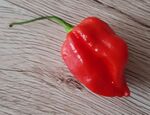
|
C. chinense | Salvatore Genovese | UK | 1,400,000[15] | |
| Chocolate 7-pot[2] | C. chinense[2] | landrace | Trinidad[2] | 1,800,000[2] | ||
| Armageddon[16] | unknown | Salvatore Genovese[16] | UK | 1,300,000[16] | ||
| Pepper X[17] | C. chinense | Ed Currie[17] | US | 3,180,000 (unofficial)[17][18] | ||
| Carolina Reaper[14] | 
|
C. chinense | Ed Currie | US | 1,569,300 | 2013 |
| Trinidad Moruga scorpion[1] | 
|
C. chinense | landrace[2] | Trinidad[2] | 1,200,000 | 2012[1] |
| Trinidad Scorpion Butch T[1] | 
|
C. chinense | Butch Taylor[6] Marcel de Wit[1][19] |
US[6] Australia[19] |
1,463,700[11] | 2011[13] |
| Naga Viper[1] | 
|
C. chinense × C. frutescens | Gerald Fowler[1] | UK[2] | 1,382,000[1] | 2011[13] |
| Infinity[1] | C. chinense | Nick Woods[20] | UK[20] | 1,176,182[20] | 2011[13] | |
| Bhut Jolokia[11] | 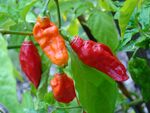
|
C. chinense × C. frutescens[2] | landrace | India[2] | 1,001,000[11] | 2007[11] |
| Dragon's Breath[21] | C. chinense | Neal Price[21] | UK[21] | 2,400,000 (unofficial)[21] | ||
| Naga Morich | 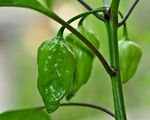
|
C. chinense[22] | landrace | India and Bangladesh | 1,000,000 | |
| Red Savina[1] | 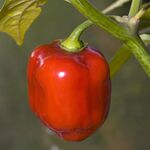
|
C. chinense[2] | Frank Garcia[2] | US[2] | 570,000[1] | 1994[1] |
References
- ↑ 1.00 1.01 1.02 1.03 1.04 1.05 1.06 1.07 1.08 1.09 1.10 1.11 1.12 1.13 1.14 1.15 1.16 1.17 1.18 1.19 Jakab, Spencer (March 26, 2013). "The Arms Race to Grow World's Hottest Pepper Goes Nuclear" (in en-US). Wall Street Journal. ISSN 0099-9660. https://www.wsj.com/articles/SB10001424127887324281004578356703455812208.
- ↑ 2.00 2.01 2.02 2.03 2.04 2.05 2.06 2.07 2.08 2.09 2.10 2.11 2.12 2.13 2.14 2.15 2.16 2.17 2.18 2.19 2.20 2.21 2.22 2.23 Hildebrand, Caz (2018). An Anarchy of Chilies. Thames & Hudson. ISBN 978-0-500-02183-5. https://books.google.com/books?id=ym-VswEACAAJ.
- ↑ 3.0 3.1 Roach, Mary (2013). "The Gut-Wrenching Science Behind the World’s Hottest Peppers" (in en). https://www.smithsonianmag.com/travel/the-gut-wrenching-science-behind-the-worlds-hottest-peppers-73108111/.
- ↑ "World's Hottest Chile Pepper Discovered" (in en). October 28, 2007. https://www.sciencedaily.com/releases/2007/10/071026162420.htm.
- ↑ 5.0 5.1 Collins, Lauren (October 28, 2013). "The Search for the World's Hottest Chili" (in en). New Yorker. ISSN 0028-792X. https://www.newyorker.com/magazine/2013/11/04/fire-eaters.
- ↑ 6.00 6.01 6.02 6.03 6.04 6.05 6.06 6.07 6.08 6.09 6.10 Anderson, Lessley (April 3, 2013). "Growing Pain: Chilihead fanatics are locked in a race to cultivate the world's hottest pepper." (in en-US). https://modernfarmer.com/2013/04/growing-pain/.
- ↑ 7.0 7.1 Bosland, Paul; Coon, Danise (2015). "(PDF) Novel Formation of Ectopic (Nonplacental) Capsaicinoid Secreting Vesicles on Fruit Walls Explains the Morphological Mechanism for Super-hot Chile Peppers" (in en). Journal of the American Society for Horticultural Science. doi:10.21273/JASHS.140.3.253. https://www.researchgate.net/publication/279564263_Novel_Formation_of_Ectopic_Nonplacental_Capsaicinoid_Secreting_Vesicles_on_Fruit_Walls_Explains_the_Morphological_Mechanism_for_Super-hot_Chile_Peppers.
- ↑ 8.0 8.1 8.2 8.3 Pierre-Louis, Kendra (March 11, 2016). "What Makes the Ghost Pepper So Spicy?" (in en-US). https://www.theatlantic.com/science/archive/2016/03/ghost-pepper-heat-research/473361/.
- ↑ 9.0 9.1 9.2 9.3 GrrlScientist (February 29, 2016). "What Makes Super-Hot Chile Peppers 'Hotter Than Hell'?" (in en). https://www.forbes.com/sites/grrlscientist/2016/02/29/what-makes-super-hot-chile-peppers-hotter-than-hell/.
- ↑ Pobjie, Ben (April 14, 2019). "Marc Fennell's new podcast It Burns" (in en). https://www.smh.com.au/entertainment/tv-and-radio/q-and-a-marc-fennell-on-fire-the-feed-and-finding-people-first-stories-20190412-p51dou.html.
- ↑ 11.0 11.1 11.2 11.3 11.4 11.5 11.6 11.7 11.8 11.9 Leckart, Steven (December 18, 2017). "In Search Of the World's Spiciest Pepper" (in en-us). https://www.maxim.com/entertainment/search-worlds-spiciest-pepper.
- ↑ 12.0 12.1 Hunt, Nicholas (September 17, 2013). "So God Made the World's Hottest Pepper" (in en-US). https://www.theatlantic.com/health/archive/2013/09/so-god-made-the-worlds-hottest-pepper/279749/.
- ↑ 13.0 13.1 13.2 13.3 13.4 13.5 13.6 13.7 Adams, Paul (July 7, 2011). "FYI: What is the Hottest Pepper in the World?" (in en). https://www.popsci.com/science/article/2011-06/fyi-what-hottest-pepper-world/.
- ↑ 14.0 14.1 "Hottest chilli pepper" (in en-GB). https://www.guinnessworldrecords.com/world-records/hottest-chili.
- ↑ 15.0 15.1 Smithers, Rebecca (August 11, 2015). "UK's hottest ever commercially grown chilli pepper to go on sale" (in en-GB). The Guardian. ISSN 0261-3077. https://www.theguardian.com/lifeandstyle/2015/aug/11/uk-hottest-ever-chilli-pepper-komodo-dragon.
- ↑ 16.0 16.1 16.2 "Armageddon arrives: Rocketing pepper demand drives Tesco launch of hottest UK-grown variety". July 30, 2019. https://fif.cnsmedia.com/a/CrkPW__rl1W8=.
- ↑ 17.0 17.1 17.2 Licata, Elizabeth (September 23, 2017). "Pepper X is the new hottest pepper in the world" (in en-US). https://www.latimes.com/sns-dailymeal-1812885-pepper-x-worlds-hottest-pepper-hot-sauce-92317-20170923-story.html.
- ↑ "'World's hottest pepper' will make you choke, sweat and cry for mercy" (in en). https://www.today.com/food/pepper-x-t116798.
- ↑ 19.0 19.1 DaSilva, Matthew (April 12, 2011). "World's hottest chilli grown by Aussies" (in en-AU). https://www.australiangeographic.com.au/topics/science-environment/2011/04/worlds-hottest-chilli-grown-by-aussies-1/.
- ↑ 20.0 20.1 20.2 Henderson, Neil (December 19, 2011). "'Record-breaking' chilli is hot news" (in en-GB). BBC. https://www.bbc.co.uk/news/uk-12505344.
- ↑ 21.0 21.1 21.2 21.3 "'World's hottest' chilli grown in Wales" (in en-GB). BBC. May 17, 2017. https://www.bbc.com/news/uk-wales-north-east-wales-39946962.
- ↑ Lim, T. K. (2013). Edible Medicinal and Non-Medicinal Plants: Volume 6, Fruits. Springer. p. 205. ISBN 9789400756274.
